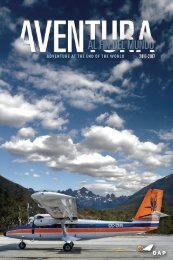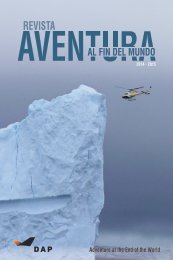REVISTA DAP AVENTURA 2015-2016
Los invitamos a conocer nuestra mirada, a través de esta nueva edición digital de revista "AVENTURA: Al Fin del Mundo", temporada 2015-2016. Cuéntanos qué te parece en facebook.com/grupodap _______/________ We invite you to know our world, in this new digital edition of "ADVENTURE: At the End of the World" 2015-2016 season. Tell us what you think on facebook.com/grupodap Enjoy!
Los invitamos a conocer nuestra mirada, a través de esta nueva edición digital de revista "AVENTURA: Al Fin del Mundo", temporada 2015-2016.
Cuéntanos qué te parece en facebook.com/grupodap _______/________
We invite you to know our world, in this new digital edition of "ADVENTURE: At the End of the World" 2015-2016 season.
Tell us what you think on facebook.com/grupodap
Enjoy!
Create successful ePaper yourself
Turn your PDF publications into a flip-book with our unique Google optimized e-Paper software.
Aventura al fin del mundo <strong>2015</strong> - <strong>2016</strong><br />
SIR ERNEST SHACKLETON AND PILOT PARDO<br />
A HUNDRED YEARS<br />
OF AN AMAZING RESCUE<br />
By Rafael Cheuquelaf Bradasic<br />
Ernest Shackleton was born in Ireland<br />
in 1874, and belonged to a species that<br />
back then already seemed condemned to<br />
extinction: the Explorers. In a world where<br />
sites to explore were growing short, this<br />
Irishman dreamt with the glory of being the<br />
first to plant a Union Jack flag in the South<br />
Pole. And he was merely 500 km from<br />
achieving so, in the “Nimrod” expedition<br />
(1909). “I thought you’d rather have a live<br />
donkey than a dead lion”, he said, when<br />
explaining why he chose to abort mission. He<br />
was still received as a hero in Great Britain,<br />
status that allowed him to give conferences<br />
in different European cities. But then the<br />
arrival of Roald Admunsen to the South<br />
Pole gave him the impulse to go back into<br />
the White Continent, putting together an<br />
expedition under the grandiloquent name<br />
of “Imperial Trans Antarctic Expedition”.<br />
As the name implied, his goal was to go<br />
through the White Continent, using sleds<br />
pulled by dogs. The text of the ad published<br />
in London press for recruiting the crew read:<br />
“Men wanted for hazardous journey. Low<br />
wages, bitter cold, long hours of complete<br />
darkness. Safe return doubtful. Honour<br />
Cutter Yelcho./ Escampavía<br />
Yelcho.<br />
and recognition in event of success.” They<br />
say over 5.000 applications were received.<br />
Finally, after the suspense following the start<br />
of the First World War, in December of 1914<br />
Shackleton received authorization to sail<br />
from Winston Churchill, then First Lord of the<br />
Admiralty, with a simple telegram: “Proceed”.<br />
After a stop in Buenos Aires, the “Endurance”<br />
ship arrives at the South Georgias. There,<br />
Norwegian whalers informed them of a great<br />
amount of ice blocking Vassel Bay, the spot<br />
Shackleton had chosen as disembarking<br />
site. Conscious of the danger, but with no<br />
intention to go back, Shackleton gave the<br />
order to advance. Finally, on February of<br />
1915 the “Endurance” can go no further,<br />
as it is stuck in the frozen Sea of Wedell.<br />
Shackleton accepts the fact that the Imperial<br />
Trans Antarctic Expedition has come to an<br />
end and begins organizing the life on board<br />
the “Endurance” as a polar station. There,<br />
the crew makes efforts to fight depression<br />
in the long Antarctic night, doing activities<br />
such as theatre plays and literature. But at<br />
the arrival of Spring, the ice starts to break<br />
and the shell of the “Endurance” gets trapped<br />
more and more in it. In October of 1915 it<br />
must be evacuated. Before the desperate<br />
looks of its crew, the ship is destroyed and<br />
sinking under the ice. They must now camp<br />
atop the unstable pieces of sea ice. It is on<br />
these desperate times where Shackleton’s<br />
extraordinary temple and leadership arise,<br />
uniting his men and ordering them to take<br />
only what is needed for survival. From the<br />
beginning, it is clear they will not stay where<br />
they are, but will rather face the torture of<br />
pushing around three life boats with them<br />
before succumbing to cold, hunger or insanity.<br />
All of the dogs end up sacrificed in the need<br />
to withhold this tremendous effort.<br />
When the ice starts to break under their feet,<br />
the men must climb on the boats and go in<br />
search of firm land. Freezing, they arrive<br />
at Elephant Island, a solitary rock hit by<br />
the storms, and miles from any route used<br />
by the whalers. From there, Shackleton<br />
decides to kick off one of most dangerous<br />
sea travels of all times: to sail with five men<br />
on “James Caird” sailboat, roughly 800 sea<br />
miles to the South Georgia island, and get<br />
help from the Norwegian whalers. Armed<br />
barely with a compass and a sextant, and<br />
standing before gusting winds and waves<br />
over 8 meters tall. Drifting even one degree<br />
from the path meant never finding the island<br />
and getting lost forever in the South Atlantic.<br />
But, against all odds, they got there.<br />
Once on firm land, Shackleton, who had<br />
never climbed a mountain in his life, went<br />
across the island’s tall mountain range<br />
with two of his men, arriving at Norwegian<br />
whalers’ station Stromness. They say the<br />
first to see them arrive was a boy who ran<br />
away scared by the look of these shipwreck<br />
survivors. And the stations’ chief, a tough<br />
Norwegian man accustomed to hardship,<br />
could not help but cry when he was able to<br />
recognize Shackleton, with whom he had<br />
ate dinner there, almost two years before.<br />
4<br />
Adventure at the End of the World




